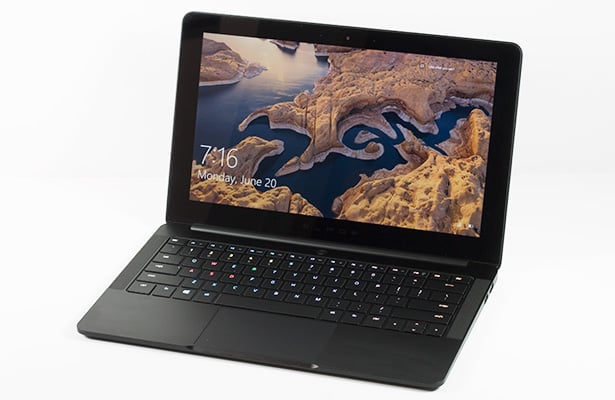Razer Blade Stealth Review
Razer Blade Stealth: Look & Feel
Razer's offerings, love 'em or hate 'em, encapsulate a gaming look more so than just about any other brand. Their mice, keyboards, and other peripherals stand out with bold shapes and bright accent colors. It's not so easy to deviate the design of a notebook just 2.75 pounds and a hair over a half inch thick from anything but boring and yet Razer found a way to make the Blade Stealth unmistakably theirs.
The Razer Blade Stealth is constructed with a CNC-milled aluminum chassis which feels both solid and cool to the touch. The sleek appearance is punctuated by two beveled lines on either side with Razer's iconic acid green triskelion snake logo illuminated dead center. We'll leave you to ponder the implications of placing snakes where Apple locates their, erm, apple but some might suggest it's almost biblical.
The bottom side is similarly clean. The most notable features here are the two long rubberized skids which provide a degree or two of tilt and honeycomb mesh covered air intakes for the tiny onboard cooling fans. Heat is exhausted from the backside into the hinge gap.
Access to the interior is provided by removing eight T5 Torx screws along the perimeter and then sliding the bottom panel away from the hinge. Approximately half of the interior is comprised of the 45Wh lithium-ion battery which does appear to be replaceable, at least by Razer technicians. About another quarter of the space is dedicated to keeping the system cool with two small fans. Each fan is affixed to a wide copper heatpipe which pair up to dissipate heat from the CPU. Finally here we can see the memory is soldered to the motherboard so sorry, no upgrades or replacements.
Port selection on the Razer Blade Stealth is a bit slim but should be sufficient for most. The left size houses a Thunderbolt 3 (USB-C) port which serves as the power jack, an acid green USB-A 3.0 port, and a 3.5mm 4-pin headset jack. The right side provides HDMI 1.4b out and another acid green USB-A 3.0 port. You won't find any on-board ethernet or optical drive which is to be expected for such a thin profile but a lack of any kind of SD card slot is a bit of a bummer. Ultrabooks are fantastic options for photographers who want to edit in the field and carrying a dedicated adapter is less than ideal.
On the flip side, while we're here, let's take a moment to show off just how thin this is next to Dell's already narrow XPS 13. The lid uses a magnetic clasp to keep closed but it can be opened with a single finger without any trouble. The hinge uses a single bar like the Dell XPS 13 which offers a very sturdy attachment and movement. It opens smoothly and stays in place decently well but is subject to slipping out of angle as you move the notebook. It shouldn't be a problem but you may want to cradle the display as you move it to prevent it from clamping shut on your fingers if you grab it solely by the base.
Inside here Blade Stealth's cover is blown. A lightshow erupts with the keyboard featuring individually backlit RGB keys. Specifically the key text is lit instead of lighting around the base of each key as some other laptops have. We will cover the software options to control the backlights on the next page but suffice to say it looks great.
A glossy 1440p (QHD) panel mirrors the keys but ultimately fails to impress. For starters, it is noticeably dim and we measured a maximum brightness of about 210 lux compared with the Dell XPS 13's 1800p (QHD+) panel which cranks out over 320 lux when the two are compared side by side. Now, 200+ lux isn't bad in general but when coupled with a glossy screen it becomes difficult to use in certain direct lighting situations. For the Razer Blade Stealth this amounts to sometimes seeing your reflection more than what's on the display. Viewing angles can at least be noted as a positive with no real distortion or discoloration at any observable angle. We just hope the 4K panel packs a better punch beyond expanding the color space to 100% Adobe RGB from 70% on the QHD option. In either case we'd also like to see the bezel's shrunk down to reduce the notebook's footprint or else expand the display a bit to get more screen real estate. Large bezels feel like dead space on an ultrabook like this and give the impression that the screen is smaller than it truly is.
Rounding out the interior tour we find a 2.0 megapixel webcam. The quality is nothing spectacular but it gets the job done. The power button is found just above the keyboard. In our opinion it could use a little more of a tactile bump when pressed but hey, it's a power button, how often do you need it? The touchpad beneath the keyboard is comprised of a single piece of glass, is roomy, and tracks well.
Top-Notch Audio Sound Quality
A pair of speakers run the length of the sides of the keyboard and wow, these might be the most impressive speakers we've heard in an ultrabook to date. Speakers can only be shrunk so much before losing fidelity at the low end so while this machine isn't a bass thumper, we appreciate that the bass is still present and rich. Additionally, the volume can be maxed out without sounding the least bit overblown. It rings especially loud registering at 72 decibels using the built-in Windows speaker test. Impressive.














